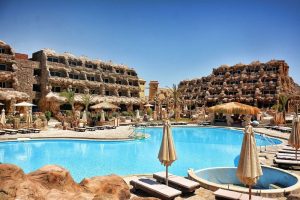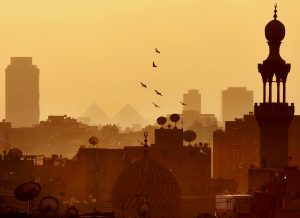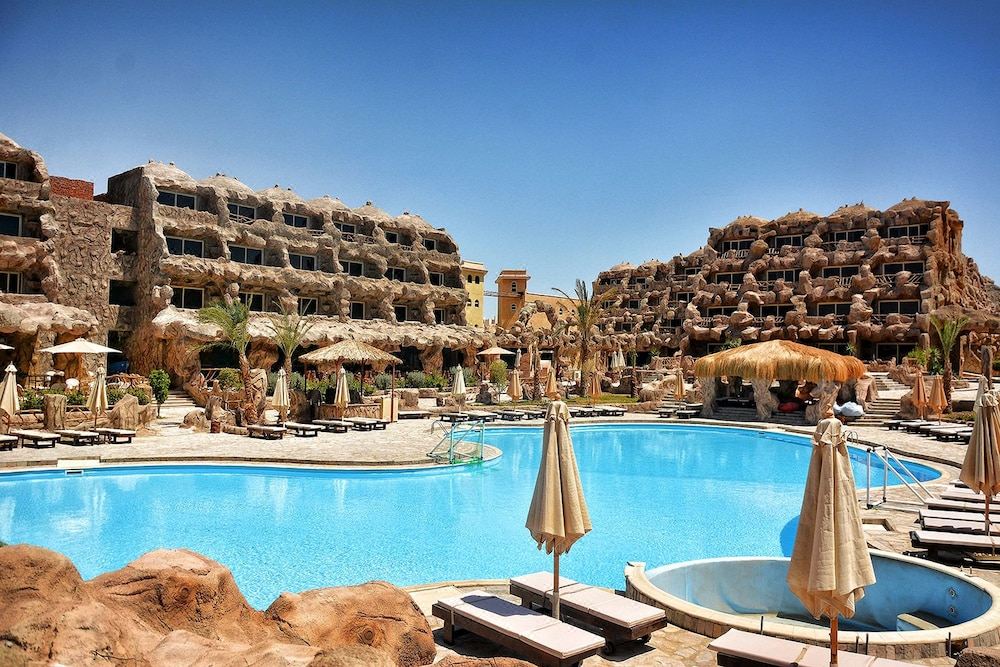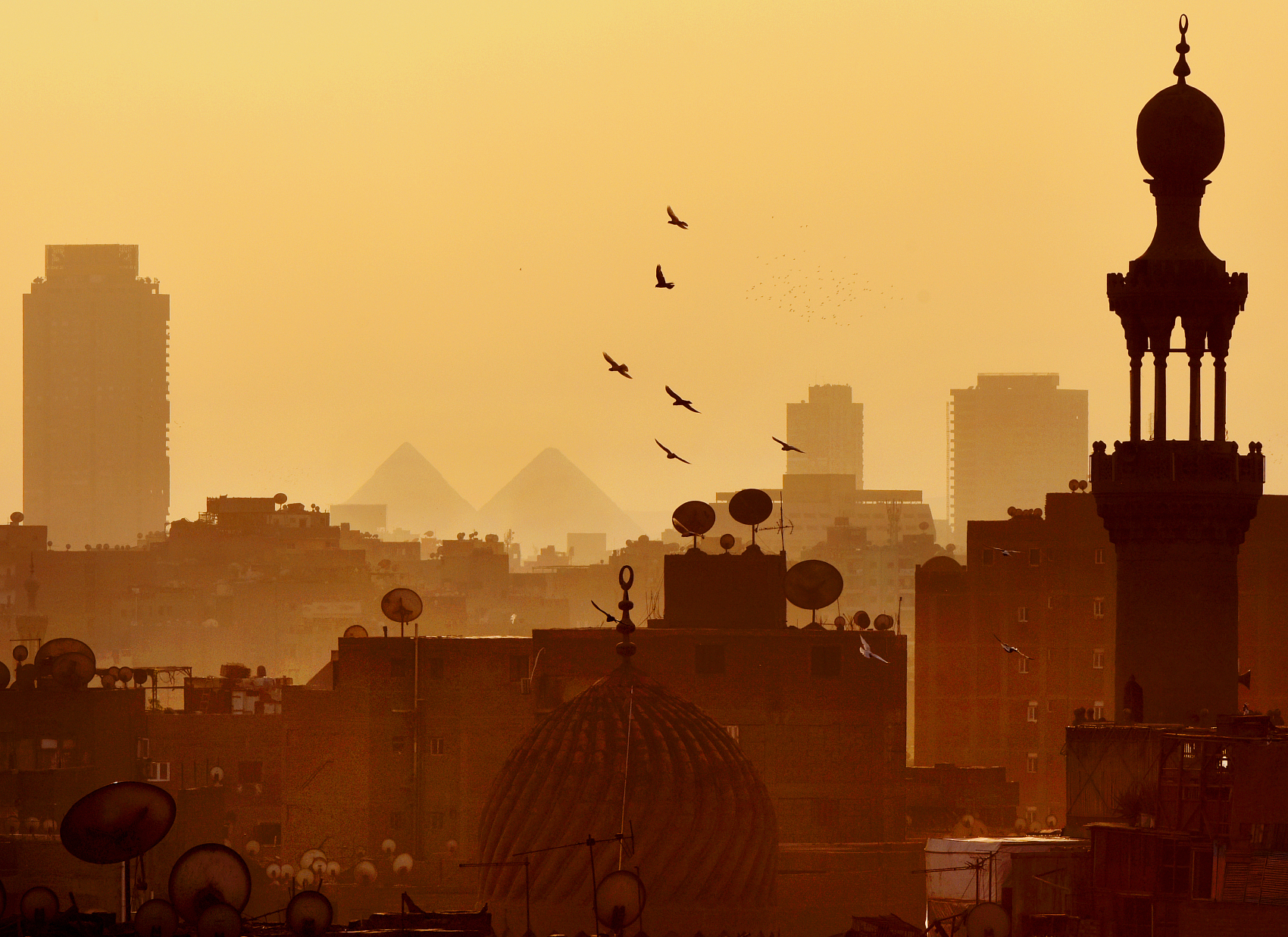When traveling to Egypt, it is important to choose the right time. Most of Egypt has a tropical desert climate, which is hot and dry all year round, but it is relatively cool from October to April of the following year, which is an ideal travel period. During this period, you can avoid the heat of summer, and it is more comfortable and pleasant to visit ancient monuments or explore in the desert. For example, in the winter from December to February, the temperature in the Nile Valley is pleasant and the daytime is warm, which is very suitable for outdoor activities; while in the spring from March to May, the weather gradually warms up, which is suitable for exploring the desert and coastal areas. At this time, going to the Red Sea to enjoy the sun and beaches, or visiting southern attractions such as the Abu Simbel Temple are all good choices.
Cairo:
The streets of Cairo are full of vitality. People of all skin colors shuttle through the streets and alleys. The shops on the street are full of Egyptian handicrafts, spices and delicacies.
The Giza Pyramids are undoubtedly the most dazzling pearl in Cairo and the most representative symbol of ancient Egyptian civilization. When I saw the three huge pyramids rising from the desert, I was shocked beyond words. The Pyramid of Khufu, the Pyramid of Khafre and the Pyramid of Menkaure are like three giants, quietly guarding this land and witnessing the changes of thousands of years. Standing at the foot of the pyramids and touching those huge stones, I couldn’t help but imagine how the ancient Egyptians built such a magnificent building with wisdom and strength without the help of modern machinery. The Sphinx next to it, with its mysterious face and majestic posture, stares into the distance, as if telling the glory and vicissitudes of ancient Egypt. In the pyramid scenic area, you can also choose to ride a camel to tour. On the back of the camel, feel the breeze of the desert, and appreciate the pyramids from different angles, which is a unique flavor.
The Egyptian Museum is a treasure house of cultural relics, which treasures the historical memory of ancient Egypt for thousands of years. As soon as you step into the museum, it seems to travel through time and space and return to the glorious era of ancient Egypt. There are a large number of cultural relics on display here, from the mummies of the pharaohs to exquisite statues, from ancient papyrus documents to gorgeous jewelry, each of which carries a profound historical and cultural connotation. Among them, the most eye-catching is Tutankhamun’s golden mask, which is amazing for its exquisite craftsmanship and gorgeous decoration. The pharaoh’s face on the mask is lifelike, as if showing people his former dignity and majesty. There is also the well-preserved mummy of Ramses II, lying quietly in the glass coffin, which makes people feel the superb mummy-making technology of ancient Egypt. In the museum, there are many precious cultural relics, such as the Narmer Palette, which records the historical moment when Narmer, the first pharaoh of ancient Egypt, unified Upper and Lower Egypt, and is an important material evidence for studying the history of ancient Egypt; the Metum Duck Group Picture, with its delicate brushstrokes and vivid depiction, shows the superb skills of ancient Egyptian artists.
Alexandria:
After saying goodbye to Cairo, I headed north along the coastline and came to Alexandria, the second largest city in Egypt. This city founded by Alexander the Great is like a shining pearl, inlaid on the coast of the Mediterranean, exuding a unique charm.
The Library of Alexandria is undoubtedly the cultural treasure of this city. This modern building, with its unique design concept and rich collection, has become one of the landmark buildings in Alexandria. The appearance of the library is like a huge tilted disc, symbolizing the sun rising from the Mediterranean, and it is also like an open giant book, waiting for people to explore its mysteries. The moment I stepped into the library, it seemed as if I had entered an ocean of knowledge. The library houses books, manuscripts, documents, etc. from all over the world, covering multiple fields and disciplines. In addition to the rich collection of books, the library also has multiple exhibition halls, museums and conference centers, and often hosts various cultural activities and academic lectures, attracting scholars and cultural enthusiasts from all over the world.
The Summer Palace, this romantic palace, is a summer resort for the Egyptian royal family. The palace’s architectural style is elegant and gorgeous, integrating European and Egyptian architectural elements. The interior of the palace is beautifully decorated, displaying many precious artworks and cultural relics, showing the luxurious life of the Egyptian royal family. The palace garden is even more beautiful, with green trees, lush flowers and plants, and various fountains and sculptures dotted among them, making people feel like they are in a fairy tale world. Walking along the path of the garden, admiring the surrounding beauty and feeling the gentle breeze, the fatigue in my heart gradually dissipated. On the beach of the Summer Palace, you can also see many locals swimming, playing, and enjoying the happiness brought by the sun and the beach. Here, I felt the leisure and comfort of Alexandria, and also experienced the unique seaside style of this city.
Aswan:
After leaving Alexandria, I continued to move south and came to Aswan in southern Egypt. This city, located on the banks of the Nile, is like a shining pearl, exuding a unique charm. It not only has spectacular natural scenery, but also carries a rich historical and cultural heritage. It is an indispensable stop for Egyptian tourism.
The Aswan Dam is undoubtedly the most iconic building in the city and a great miracle in the history of human engineering. When I stood on the dam, overlooking the rushing Nile River being cut off in the middle, I couldn’t help but feel awe in my heart. The dam was started in 1960 and took 10 years to complete. It was very expensive. It is 111 meters high, 3,830 meters long, 980 meters wide at the bottom and 40 meters wide at the top. It used 43 million cubic meters of earth and stone, which is 17 times the volume of the Great Pyramid of Khufu in the western suburbs of Cairo. The completion of the dam not only solved the threat of Nile flooding to Egypt, but also provided Egypt with a stable power supply and irrigation water source, which had a profound impact on Egypt’s economic and social development. Standing on the observation deck of the dam, you can see the vast Lake Nasser, the lake is sparkling under the sunshine, and occasionally there are boats passing by on the lake, causing ripples. The mountains in the distance are rolling and the lake is in contrast, forming a beautiful picture. The water conservancy facilities on both sides of the dam are in good order, showing the grandeur and magnificence of modern engineering.
Philae Temple is another treasure of Aswan. It is like a mysterious art palace, telling the glory and mystery of ancient Egypt. Located on Philae Island, 15 kilometers south of Aswan, this temple was built to worship Isis, the goddess of fertility and reproduction in ancient Egyptian mythology. It is one of the three best existing temples of the Ptolemaic Dynasty in ancient Egypt. The temple has a unique architectural style, which combines the architectural features of ancient Egypt and ancient Greece and Rome. The tall stone columns, exquisite reliefs, and mysterious murals, every detail shows the exquisite skills and infinite wisdom of ancient Egyptian craftsmen. The two stone lions at the entrance of the temple are majestic and guard this sacred temple, which is extremely rare in other ancient temples in Egypt. Entering the temple, it seems to travel through time and space and return to the mysterious world of ancient Egypt. The reliefs and murals on the walls vividly depict the myths and religious rituals of ancient Egypt, which makes people sigh at the profoundness of ancient Egyptian civilization. However, due to the construction of the Aswan Dam, Philae Island was submerged. In order to protect this precious monument, the Egyptian government, with the help of UNESCO, launched a massive rescue project. Experts and engineers first separated Philae Island from the lake with iron plates, drained the water on the island, and then cut the Philae Temple into tens of thousands of pieces, transported them to the nearby Ajilek Island, and reassembled them according to their original appearance. The entire project took many years and finally allowed this ancient temple to see the light of day again.
Luxor:
Continuing along the Nile River, I came to Luxor, known as the “world’s largest open-air museum”. This city is like a vivid history book, and every brick and stone tells the glory and vicissitudes of ancient Egypt.
The Luxor Temple is undoubtedly the shining pearl of this city. It is located on the east bank of the Nile in the center of Luxor. It is an outstanding architectural representative of the New Kingdom period of ancient Egypt and was built to worship the sun god Amon. This temple was built in the 14th century BC by Amenhotep III for the Opet Festival. It was later expanded on a large scale by Ramses II to form the scale we see today. When you enter the temple, the first thing that comes into view is the magnificent pylon. It is tall and majestic, as if telling the supreme authority of the ancient Egyptian pharaoh. On both sides of the pylon stand two 14-meter-high seated statues of Ramses II. Although the years have left traces on them, they still make people feel the pharaoh’s ambition and heroic spirit. Walking into the interior of the temple, the courtyard is spacious and open, and the ground is paved with huge stone slabs, as if showing people the exquisite craftsmanship of the ancient Egyptians. Surrounding the courtyard are tall colonnades. These stone columns are made of papyrus bundles, and the tops of the columns are in the shape of umbels, which are elegant and unique. The columns are full of exquisite reliefs, depicting ancient Egyptian myths, religious rituals, and the great achievements of the pharaohs. Every detail is lifelike, which makes people marvel at the superb skills of ancient Egyptian craftsmen. Going further in, it is the main hall. The walls of the hall are inlaid with colorful stone slabs, on which are painted portraits of various gods and pharaohs. The colors are bright and dazzling after thousands of years. At the northern entrance of the Ramses Courtyard of the temple, there is a uniquely shaped colonnade, consisting of 14 stone columns about 16 meters high. There is also a stone statue of Pharaoh Ramses II in the middle of the stone column. The stone wall next to it is engraved with the scene of the celebration ceremony, which makes people seem to travel through time and space and return to that ancient and mysterious era.
On the west bank of Luxor, there is a mysterious and legendary place hidden – the Valley of the Kings. This is the resting place of the ancient Egyptian pharaohs and the place that many archaeologists dream of exploring. There are 64 royal tombs in the Valley of the Kings, where many famous pharaohs such as Thutmose I and Ramses II are buried. In 1922, an archaeological team led by British archaeologist Howard Carter discovered the entrance to the tomb of the ancient Egyptian pharaoh Tutankhamun. The discovery of this tomb shocked the world and gave people a deeper understanding of the history and culture of ancient Egypt. A large number of precious cultural relics were unearthed from Tutankhamun’s tomb. The most famous one is the 11-kilogram gold mask, which is made of pure gold and inlaid with lapis lazuli and various gems. It is exquisitely crafted and beautiful, showing the superb skills of ancient Egyptian craftsmen and the splendor of ancient Egyptian civilization. In addition to Tutankhamun’s tomb, other tombs in the Valley of the Kings also have their own characteristics. Although most of them have been visited by tomb robbers, the dignity and majesty of the ancient Egyptian pharaohs can still be felt from the remaining murals and reliefs.
Food Tour:
Traveling in Egypt is not only a visual feast, but also a carnival for taste buds. The food here combines thousands of years of history and culture with unique regional customs, and each dish seems to be telling an ancient story. Kushari can be called Egypt’s “national food”, and it can be seen everywhere in the streets and alleys of Egypt. This delicacy is like a wonderful party of ingredients, bringing together ingredients such as rice, macaroni, lentils, onions and tomato sauce. First, these ingredients are carefully cooked separately, then stirred together when eating, and then garlic vinegar, chili sauce and other seasonings are added according to personal taste. With one bite, the taste of various ingredients interweaves with each other, the softness of rice, the chewiness of macaroni, the density of lentils, the sweetness of onions and the richness of tomato sauce, the rich layered feeling instantly blooms on the tip of the tongue, and every bite is full of satisfaction. At the Koshary Abou Tarek restaurant in Cairo, you can taste the most authentic Kushari. This restaurant is very popular, and many diners come here every day. It is common to wait in line, but for that delicious taste, all the waiting is worth it.
Malva soup is a very distinctive traditional delicacy. Its history can be traced back to the ancient Egyptian period. It was once a delicacy on the table of the Pharaoh. This soup is made from mallow leaves, which are abundant on both sides of the Nile River. The mallow leaves are washed, dried, crushed, and then boiled with chicken, lamb, butter, garlic, etc. The soup is thick, green and sticky, and tastes delicious. Mallow soup is often poured on rice by Egyptians. The rich soup instantly injects soul into the bland rice, and the two complement each other. In some traditional restaurants in Cairo, such as Abou El Sid Restaurant, you can taste this delicious mallow soup. The environment of the restaurant is full of rich Egyptian style. While tasting the food, you can also feel the unique charm of ancient Egyptian culture.
As Egypt’s traditional bread, pita bread has a long history. It is round in shape, hollow in the middle, like a cute pocket, so it is also called “pocket bread”. It has a soft and tough texture and is widely used. It can be eaten directly to feel its rustic wheat aroma; it can also be used to dip sauces and match with various delicious sauces, such as hummus, tahini, etc., to make simple bread rich and varied; it can also be filled with smoked chicken, ham, fried eggs, fresh vegetables, pickles and other ingredients to make delicious sandwiches, and every bite is full of surprises. You can easily buy freshly baked pita bread in Egyptian markets and bakeries. The steaming pita bread exudes an attractive aroma that makes people can’t help but take a bite.
Travel tips:
When traveling in Egypt, respecting local religious culture is the first priority. Egypt is a Muslim country. When going to religious places such as mosques, be sure to dress appropriately. Women need to wear headscarves and avoid wearing revealing clothing, such as low-cut clothes, tight clothes, sleeveless tops, shorts that expose the area above the knee, miniskirts, etc.; men should not be shirtless or wear shorts that are too short. During religious ceremonies, keep quiet and do not disturb or behave disrespectfully. During Ramadan, you should understand and respect local fasting customs, avoid drinking, eating or smoking in public places or in front of Muslims, do not persuade Muslim friends to smoke or eat, and do not question whether Muslims are really fasting or make other provocative remarks out of curiosity.
Safety issues should not be ignored. When traveling, pay close attention to the local security situation and avoid going to sparsely populated, unopened or unsafe areas, such as the North Sinai Peninsula. In crowded places, such as markets and scenic spots, pay special attention to the safekeeping of personal belongings, place luggage within visible range, and carry cash, valuables and passports with you. When taking transportation, choose regular taxis, online car-hailing or public transportation, and avoid taking vehicles without operating qualifications. Cairo’s traffic conditions are complicated. When traveling, you must pay attention to traffic safety, abide by traffic rules, and be careful when crossing the road.
When traveling in Egypt, understanding and respecting the local religious culture in advance, paying attention to safety precautions, and being vigilant against fraud can make our journey smoother and more enjoyable, and we can fully enjoy the unique charm of this mysterious country.







